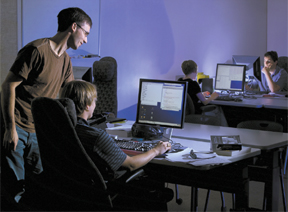
Summertime means longer days, warmer weather, and often, a break from the regular routine. For a number of Sandians, that break includes mentoring an intern through the Enabling Predictive Simulation Research Institute (EPSRI) [www.esc.sandia.gov/epsri]. This program, now in its second year, brings dozens of graduate students from across the country to Sandia to work on focused projects in the engineering sciences.
“The interns gain a sense of what kind of engineering and research work is happening here and they get to experience our research-oriented and collaborative environment,” says Jonathan Zimmerman (8776). “The mentors get a sense of research happening outside the Laboratory in the academic community and how our work relates.”
The EPSRI started last year as a joint effort between Centers 8700 and 1500 to perform cutting-edge research and development that enables the application of predictive simulation capabilities. Jonathan coordinates the EPSRI program in California, along with Scott James (8757) and James W. Foulk III (8776). The New Mexico program is coordinated by Basil Hassan (1541).
This summer, 30 interns split evenly between the California and New Mexico sites spent 10 weeks working in technical areas such as structural dynamics, solid mechanics, material mechanics, electromagnetics, electrical science, and thermal, fluid, and aero sciences.
During the summer, EPSRI hosts a series of staff technical talks for the interns. “The purpose is to give the interns a flavor of how we use our engineering education to tackle the problems we face here,” says Jonathan. The students present their work in a seminar at the end of their internship.
Each student is paired with a mentor, whose technical area complements that of the student. Ideally, the project a student works on while at Sandia ties directly into his or her thesis project.
Timothy Kostka, a graduate student in mechanical engineering at the University of California, Berkeley, says Sandia is the only institute he knows of where he can do modeling and predictive research with a team of collaborators using large-scale computing resources.
“Having access to the computational power of Sandia and many great people is a unique opportunity,” he says. “I’m working on really interesting stuff, not busy work, that will help me with my doctorate.”
This is Timothy’s second year as an EPSRI intern; he also spent two summers interning at Sandia while he was an undergraduate at Cornell University.
Another EPSRI intern is Garritt Tucker, a graduate student in computational mechanics and materials at Georgia Tech. “I’ve been able to see really interesting work, things I never considered for my PhD research,” he says. “It’s a great opportunity to see things on a grander scale.”
This summer, Garritt worked with Jonathan on atomistic simulations of deformation of microstructural features, looking at different fields of stress and deformation that are specially defined at small scales. This work helps identify key physical features of nano-structured materials that are needed to construct predictive engineering-scale models.
While EPRSI is only two years old, Center 8700 has been doing an engineering sciences summer institute for the past 10 years. Such programs provide a pipeline for new hires and strengthen ties with the academic community. Jonathan estimates that at least 10 former engineering sciences interns have been hired into Sandia in as many years.
Michael Jew (8774) interned at Sandia during the summer of 2002, when he was a graduate student at UC Berkeley. “Being an intern at Sandia was really eye-opening, in a good way,” he says. “I didn’t expect the campus-like environment here, or all the different disciplines at such a relatively small site.”
Former Sandians who have gone on to careers in academia also continue to send their students to the program. In the program this year are graduate students of two former Sandians: Richard Regueiro, an assistant professor in the Civil, Environmental, and Architectural Engineering Department at the University of Colorado, Boulder; and Mark Horstemeyer, a mechanical engineering professor at Mississippi State University.
Neville Moody (8758) has mentored some 25 interns and postdocs over the past 15 years. This summer, he’s taken under his wing John Yeager, a materials science graduate student at Washington State University. Years ago, Yeager’s advisor, David Bahr, interned with Neville. (Neville’s relationship with Bahr started at the University of Minnesota, where they shared an advisor.)
“It’s been great to work one-on-one with Neville. The equipment here is great and I’m getting a lot more done here than I would at my university,” says John.
Over the summer, John worked with Neville on a project testing flexible substrate materials. The testing method is different than the one John has been using at school; for his thesis, he’ll compare the two methods. The project is part of a Laboratory Directed Research and Development project, on which Bahr is a collaborator.
“Having an intern adds a great dimension to the work environment,” says Neville. “Students bring a fresh perspective and they are totally dedicated to the work, since it’s often part of their PhD project.”
John is partially funded by Sandia, and hopes to be back as soon as next spring after he finishes his last two classes. He’d like to extend his stay at Sandia as a postdoc after he graduates. — Patti Koning